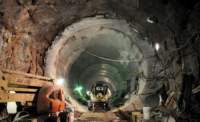A 1.1-mile bridge carrying 160,000 vehicles per day on the Brooklyn-Queens Expressway through an industrial district—and over a long-polluted waterway—might not be the first place to look for green design and construction approaches.
But the New York State Dept. of Transportation’s construction of the replacement for the I-278 Kosciuszko Bridge—a project set to cost nearly $900 million and well along in its first phase—has a big sustainable design component, and could bring lasting environmental benefits to a long-distressed area.
“Just the nature of the area was a challenge,” says Robert Adams, the bridge’s DOT project director through its planning stages over the past 15 years. “This section of the BQE winds through a mostly industrial area, and that’s on both sides, Brooklyn and Queens.”
At the site’s epicenter is Newtown Creek, which divides Brooklyn and Queens and was once a major commercial canal that after decades of pollution and neglect finally got designation in 2010 as a federal Superfund cleanup project. Making sure the new bridge did not compound those problems was a major focus, Adams says.
“Eventually, it’s going to be clean,” he says. “We at least wanted to contribute to the cleaning and improvement of the creek.”
The effort tallies various sustainable design elements to benefit both the waterway and nearby communities, including an innovative pile-driving strategy, extensive green streetscaping and a stormwater management system. Incorporating such concepts was a key aspect for project bidders, Adams says.
“Right off the bat, the [request for proposals] required any design builder interested in this first phase to do that,” he says.
A Big Platform
Replacing the deteriorating 76-year-old Kosciuszko Bridge has been a high-profile effort all along. The $555-million design-build first phase is the largest contract the DOT has ever let, fueled by both state and federal funding.
With the New York City office of HNTB as lead design firm and the construction joint venture of New York City-based Skanska, Yonkers, N.Y.-based Ecco III and Omaha-based Kiewit, the phase began in 2014 after earlier planning by Parsons Brinckerhoff and Hardesty and Hanover. The two span, nine-lane structure will feature New York City’s first vehicular cable-stayed design, using complex cantilevering methods during construction.
In that context, the green design elements have taken a backseat in the project’s profile. But they still are critical, says Brooklyn Borough President Eric Adams, in hailing the bridge’s importance to regional transportation and commerce. He cited the “additional measures to improve the local environment and expand open space [to] address key quality of life concerns in [the] Greenpoint [section of the borough] and the surrounding communities” as key benefits.
The current phase—set for completion next year—has already featured the tailored pile-driving method, but most green elements will come during the second phase between 2018 and 2020 and at the new Sergeant Dougherty Park in Brooklyn, which will be bid later this year, according to the DOT’s Robert Adams. The project team also will remove the existing bridge.
Green features now are gaining in visibility on infrastructure projects, says Brendan Owens, chief of engineering at the U.S. Green Building Council, which runs the widely used LEED sustainable construction guidelines. “There certainly is an appetite for how infrastructure can leverage green designs and principles,” he says.
A key catalyst for the trend is the Institute for Sustainable Infrastructure, which has seen a spike in use of its Envision infrastructure design and construction rating system and guidelines, says Denise Nelson, a spokeswoman for the Washington, D.C., group, which manages the rating system and certifies raters.
ISI so far has 13 infrastructure projects that have qualified for Envision ratings since the system launched in 2011, with 25 more formally pursuing the designation and another 60 at earlier stages, Nelson says. She predicts “a big jump forward in transportation for us.”
In Harmony
The Kosciuszko Bridge is seeking a different sustainable construction certification, through the state DOT’s GreenLITES program, modeled on LEED and the University of Washington’s Greenroads initiative. It is aiming for the top “platinum” level, Adams says.
These programs rate road and bridge projects on various criteria—including minimizing impact on natural habitats and floodplains, using recycled materials, managing stormwater, limiting excavation and minimizing light pollution.
One of the Kosciuszko project’s biggest goals is to avoid disturbing and spreading soils that through the years had absorbed pollutants from factories, refineries and other facilities along the creek’s corridor, Adams says. “This entire area has been in industrial use for well over 100 years, and there are levels of contamination—soil and groundwater—throughout the project,” he says. Most of that is in the top 20 to 30 ft, some of it hazardous, he says.
Environmental officials warned that the project might lead to contaminated soils penetrating a sensitive layer of Raritan clay 60 ft underground in Brooklyn, he adds.
“Our design-builder was able to come up with a very innovative solution in using a particular type of pile to support the bridge foundations,” Adams contends. “It was a typical steel-type pile, but at the end there is a closed, tapered section that allowed them to achieve the load capacity needed to support the structure, but at a much shallower depth.”
The shorter piles not only stand 10 to 15 ft above the clay layer, but also limit the need to excavate more contaminated soil, according to Adams. “That’s not an approach we had used before,” he adds.
Shelter for the Stormwater
Localized flooding and rainwater management has long been a problem for the neighborhoods around the creek, with much of the area lacking both stormwater and sanitary sewers, Adams says. The existing bridge made it worse, because a widening project in the 1960s removed the original 1939 structure’s stormwater drainage system, he says.
“So what resulted was that in heavy rains, the stormwater would freefall to the ground,” he says, bringing whatever contaminants, oils and automotive fluids it picked up into the creek.
The new system will capture all stormwater runoff in scuppers and move it through downspouts to a chamber that is designed to remove all sediments, fine particles, pollutants and even solid road salts and motor oil. By the end of the process, clean water will discharge into the creek.
The feature was not the first choice of residents who had hoped the Kosciuszko would be the first city bridge to have stormwater flow directly into the sewer system, according to Mitch Waxman, the historian of the Newtown Creek Alliance, a local environmental activist group, who also is a member of the bridge project’s stakeholders advisory committee.
“The environmental community is not exactly happy about this,” he says. “But we’re told by the engineers that this mechanism will work … and so it’s like [accepting what] your doctor says.”
City officials are hopeful that the new system may have the most positive impact of all of the project’s green features, Adams points out. “We believe that will have a really long-lasting benefit,” he adds.
Parks, Streetscapes and Pylons
Another set of green design elements aren’t on the bridge, but rather in extensive street redesign and parkland improvements nearby, Adams says.
The highlight is the planned transformation of Sergeant Dougherty Park in Brooklyn from an asphalt playground “in total disrepair” into a larger space with more sport and play areas and new rain gardens, trees and grass, he says.
Other examples include stormwater management features—such as bioretention rain gardens, bioswales with vegetation and infiltration basins —in streetscape improvements the project team is overseeing, Adams says.
The project also aims to recycle 90% of construction materials, including some that will be reused on later phases; it also features LED fixtures above and below the roadway to reduce light pollution, Adams says.
In addition, the new bridge will no longer have pylons for its main towers sitting partially within the creek, restoring its natural volume and replacing deteriorated bulkheads with broken stone to create an additional habitat for fish and wildlife and more floodplain areas, he says.
But the biggest environmental plus may ultimately be replacing the current bridge and its chronic congestion, lack of breakdown lanes and ill repute as a prime regional bottleneck, Waxman says.
“Rather than having a 24-hour jam coughing up emissions that settle as a layer of soot on the creek and [people living nearby], the real benefit will be the traffic just moving along,” he says.







